


|
|
Rainbow Tourisms :
Holidays Packages :
Pilgirimate Tour
Buddhist Circuit ToursDestinations Covered: Bodh Gaya - Dungeshwari
Caves - Kesariya - Vaishali - Rajgir- Nalanda - Kushinagar - Sarnath -
Varanasi Buddhist Circuit Tour Duration: 08 Nights / 09 Days 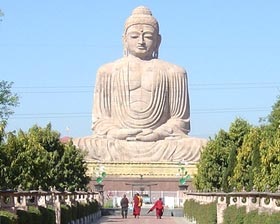 Day 01: Gaya/Bodh Gaya Arrive in Gaya. Drive to Bodh Gaya 13 km and check into hotel. Take a sightseeing tour of this holy seat of the Buddhist religion. Here is where Gautam Buddha achieved enlightenment while meditating under a bodhi tree. There is a serene temple here, as well as the offshoot of the tree that offered shade to Buddha. The original tree was destroyed by Emperor Ashoka's queen, but a sapling of it was saved in time and planted in Sri Lanka by his daughter. A sapling of that tree was brought back to Bodh Gaya, which still stands to tell this tale. A number of Buddhist nations like Thailand, Japan and Burma have set up monasteries and meditation centres in Bodh Gaya. Some of these include: the Indosan Nipponji temple, the Thai monastery, the Tibetan Karma Temple and Namgyal Monastery, and others by the Chinese, Burmese, Bhutanese, Vietnamese, Tamang, Daijokyo and Nepali Buddhist communities. During October and March, monks from Dharamsala descend to Bodh Gaya. The Dalai Lama pays a visit here too during December and January. The Mahabodhi temple is a World Heritage site, built adjacent to the site of enlightenment in the 6th century AD. The temple was attacked and plundered by Muslim invaders in the 11th century and re-built several times. Return to hotel for overnight stay. Day 02: Bodh Gaya - Dungeshwari Caves - Gaya After breakfast, proceed to Dungeshwari cave temples, 13 km. Here Buddha spent years of penance before attaining 'nirvana' or enlightenment. After lunch, return to Gaya to visit the Brahmajuni Hill, believed to be the site of Buddha's fire sermon. There is a cave and a temple on the hill top. Return to hotel for night stay. Day 03: Bodh Gaya - Rajgir After breakfast, depart for Rajgir, 70 km, 2 hrs by road. Arrive in Rajgir and check into hotel. Rajgir was the capital of the Magadha kingdom and is a pilgrimage for Jains and Hindus as well. The Japanese Buddhists have built the massive Vishwashanti Stupa on the Ratnagiri Hill which can be accessed by a chairlift. The stupa has statues of Buddha at the four stages of his life - birth, enlightenment, teaching and death. From the hill top, the Jain shrines can also be viewed, scattered across 26 distant hills. Griddhakuta, located on Ratnagiri Hill is another site where Budhha stopped by to preach. Return to hotel for night stay. Day 04: Rajgir - Nalanda After breakfast, proceed to Nalanda, 12 km. Spread over 14 hectares, the Nalanda University Ruins Archaeological Complex is set amidst expansive lawns which offset the spectacular layout and carvings of this ancient university. The monasteries and the viharas are separated by a central valley. Interesting structures to look out for include: steps leading up to perhaps a dais for professors and stupas with images of the Buddha carved in. According to the Chinese traveler Xuan Zang who also taught at the university during 685 and 762 AD, 10,000 monks and professors resided here at the time. After the walk around the ruins, visit the Xuan Zang Memorial Hall, a Chinese pagoda built by Chinese Buddhists. Return to Rajgir hotel for night stay. 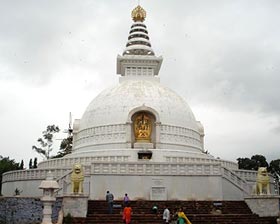 Day
05: Rajgir - Patna Day
05: Rajgir - PatnaAfter breakfast, proceed to Patna by road, 80 km. Arrive in Patna and check into hotel. Patna is Bihar's capital city and can be used as a base to visit the Buddhist sites of Vaishali and Kesariya. It also rests on its ancient past as Pataliputra, the capital of the various dynasties that ruled over the region. After lunch, take a local sightseeing tour of Patna. This would include: Golghar (built as a granary), Gandhi Museum, Patna Museum, Har Mandir Takht, Qila House or Jalan Museum with some really rare relics like Napolean's bed and Marie Antoinette's porcelain; and the ruins of Pataliputra. Return to hotel for night stay. Day 06: Patna - Vaishali - Kesariya After an early breakfast, depart for Vaishali, 44 km. This is where Buddha preached his last sermon. The ruins of the Kolhua complex enclose the 2300 year old Ashoka pillar. A Japanese Peace Pagoda has also been built here. After lunch, proceed to Kesariya, 70 km. Kesariya marks the site where Buddha gave away his begging bowl before his death. A massive Buddhist stupa built during the rule of the Pala kings is being excavated here. Return to Patna for overnight stay. Day 07: Patna - Kushinagar - Gorakhpur After breakfast, depart for Kushinagar, 220 km by road. Or else, you can take the train to Gorakhpur and drive 55 km from there to this historic town. Arrive in Gorakhpur and check into hotel. Buddha breathed his last here, leaving a message for all mankind to find their salvation. Several monuments built by devotees from across the world have built monuments on this holy site along the Buddha Marg. These include: Vietnam's Linh Son Buddhists temple, meditation centre and gardens, the Burmese Mahasukhamdadacham Thargyi Pagoda, the Mahaparinirvan Temple with a tranquil and reclining Buddha and the Matahkuar temple, the Japanese - Sri Lanka temple and the Wat Thai temple. The Ramabhar Stupa, or the Mukutbandhan Stupa is the site of the cremation of Buddha. Return to Gorakhpur for overnight stay. Day 08: Gorakhpur - Sarnath Depart in time for train to Varanasi which is 5 ½ hrs from Gorakhpur. Arrive in Varanasi and check into hotel. Take a short break before heading to Sarnath, 10 km. At Sarnath, Buddha gave his first sermon to a small band of followers after attaining nirvana. Emperor Ashoka had monastaries and stupas built here which were destroyed by Muslim invaders in later years. Some remains were discovered by British archaeologists in 1835. Sarnath is one of the four main sites of the Budddhist religion, the others being Bodhgaya, Kushinagar and Lumbini in Nepal. Return to Varanasi for night stay. Day 09: Varanasi - Delhi/Mumbai/Onward Destination After breakfast, take a tour of this holiest of cities for the Hindus. The River Ganga is the lifeline of the city, and all spiritual and religious activities are performed along its banks. Take a cruise along the river between the Dasaswamedh Ghat and Harishchandra Ghat and visit the temples. Participate in or observe the "Ganga aarti" in the evening, a spiritually uplifting experience in which the holy river is paid homage. Take the evening flight out to Delhi or your preferred destination. Tour Ends. Kailash Mansarovar YatraDestinations Covered: Delhi - Bhimtal - Dharchula
- Gala - Budhi - Gunji - Kalapani - Navidhang - Taklakot - Lake
Mansarovar - Qugu - Kailash Parikrama - Darchen - Deraphuk - Zutulphuk
to Darchen - Darchen Kailash Mansarovar Yatra Duration: 25 Nights / 26 Days Day 01: Delhi - Bhimtal 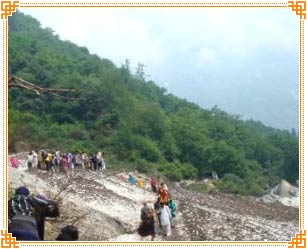 Arrive in Delhi and board train to Kathgodam, 240 km, 8 hrs Arrive in Delhi and board train to Kathgodam, 240 km, 8 hrsBoard a bus from Kathgodam to Bhimtal, 40 km,1 hr Arrive in Bhimtal and check into Rest House for the night. Day 02: Bhimtal - Dharchula Depart early for Dharchula, 313 km, 14 hrs Brief halt at Chaukori for lunch. From here, view the Nanda Devi peak, standing taller than Mt. Kailash at 22,027 ft. Nanda Devi is believed to be the abode of Shiva's consort, Parvati. Arrive in Dharchula and check into Rest House for the night. Day 03: Dharchula - Gala Depart for Mangti, 43 km, 3 hrs by bus. Arrive in Mangti and astride a pony for rest of the journey to Gala. The journey is through very picturesque country. Overnight stay in camp at Gala. Day 04: Gala - Budhi Early morning, start descent to reach Budhi, 18 km, at a height of 8,900 ft. 4,444 steps take you down to Budhi, taking almost 11 hrs to cover the 18 km. Brief halt at Lakhanpur for lunch. The gently rolling Kali River, which demarcates the Indian border with Nepal flows along the entire stretch to Budhi. Arrive in Budhi and check into huts run by the Kumaon Mandal Vikas Nigam for night stay. Day 05: Budhi - Gunji After breakfast, climb the Chhialekh hill adjoining Budhi on a pony. The 2 km ascent up by 1510 ft higher takes about 2 hrs to cover. From Chhialekh, walk a flat stretch of lovely meadow country towards Garbyang. Continue the rest of the 8 hr trek to Gunji village. Camp at Gunji for a day to acclimatize Day 06: Gunji Take a break from the long hours of trekking and pony riding and gather your energies for the second phase of the trek. Day 07: Gunji to Kalapani Fresh after a day's break, start the next leg of the journey to Kalapani through some enchanting landscape dotted with coniferous trees, following the Kali River. Trek time is 11 hrs through 9 km. Take a dip in the hot springs near Kalapani and pay homage to the gods at the temple marking the source of the River Kali. Towering over the site is the Vyas Gufa, or the cave where Sage Vyas meditated and penned the Mahabharata. Overnight camp at Kalapani. Day 08: Kalapani to Navidhang After breakfast, proceed to Navidhang, The 9 km journey will take 6 hrs, to altitudes where the trees give way to lower order plants. The magnificent Om Parbat reveals itself - the snow falls on the mountain clearly defining the "Om" shape. Overnight camp at Navidhang Day 09: Navidhang - Lipu Lekh Pass - Taklakot This day, the crossover to Tibet is made through the Lipu Lekh Pass. This is at 17,828 ft, and the 9 km stretch takes 4 hrs to cover. The pony ride starts at 3 am to avoid inclement weather. Across to the Tibetan/Chinese border by 7am, and post immigration formalities, board a bus to Taklakot, 22 km. This is an elevated flatland at 13,123 ft. Overnight camp at Taklakot. Day 10: Taklakot Taklakot offers communication and shopping facilities, and also a 2nd break in the long journey to Mount Kailash. You may purchase Chinese currency here. Overnight camp at Taklakot 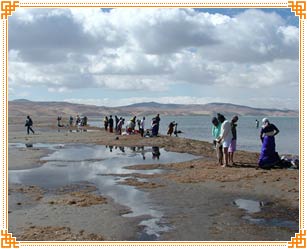 Day
11: Taklakot - Lake Mansarovar Day
11: Taklakot - Lake MansarovarDepart at 6 am by bus for the Gurla Pass at 16,125 ft. The Gurla Mandhata peak is to the right, touching 25,354 ft. Here from Gurla Pass, you can get the first sight of the divine peak. Proceed to Rakshas Tal, 70 km, 4 hrs from Taklakot. Here, soak in and experience the most heavenly sight on earth. Mount Kailash, a high pyramid of snow, towers above the surrounding hills. Continue journey in bus to Manasarovar through absolutely divine landscape. Arrive in Lake Manasarovar. Alight by the shores and walk carefully into the soft soil around the lake at Qihu. Prepare for the parikrama around Mount Kailash, followed by a parikrama of Lake Manasarovar. A road encircles the Lake. Hore and Qugu are two camps on the eastern and southern shores of the route, 40 km and 85 km respectively from Qihu. Camp at Qugu for the night. Day 12: Qugu, Manasarovar Finally, the day of the holy dip in Lake Manasarovar. Rise early before the chilly winds start and proceed to the Lake. After the dip, proceed towards the monastery near the Lake for a "havan" ceremony. An awesome celestial experience. It is a belief that the gods descend in the wee hours of the day to take a dip in the Lake. You may brave the cold and the winds to experience the ambience of the lake at night. Day 13: Qugu, Manasarovar Spend a day at the camp at Qugu, admiring the Lake. Visit the hot springs in the vicinity during the day. Day 14: Manasarovar Parikrama (Qugu - Darchen) After some time spent along the Lake, proceed to Darchen, 57 km, 3 hrs by bus. From Darchen, complete the rest of the parikrama on foot, covering 15 km in 5 hours across the Barkha Plain. Camp at Darchen for the night. Day 15: Kailash Parikrama - Darchen - Deraphuk The day everybody's been waiting for is here. The circuit around Mount Kailash starts from Yama Dwar, 5 km from Darchen. Alight a pony to start the parikrama up to Deraphuk at 17,000 ft. Soak in the views of Mount Kailash from here. Camp at Deraphuk for the night. Day 16: Kailash Parikrama - Deraphuk to Dolma La to Zutulphuk Catch a magnificent view of the sun shining on Mount Kailash Continue parikrama from Deraphuk to Dolma La, the highest peak on the route, at 18,602 ft. Prepare yourself mentally and physically for the steep climb. The Buddhists revere this peak, and the Hindus worship it as Tara Devi. The descent from Dolma La continues to be difficult, and meets Gauri Kund, the highest freshwater lake in the world, and where Parvati, Shiva's consort bathes. Continue trek towards valley and halt here for a break before proceeding to Zutulphuk at 15, 715 ft. Arrive in Zutulphuk before sunset. Camp at Zutulphuk for the night. Day 17: Zutulphuk to Darchen Relatively level ground prevails on the trek back to Darchen, covered in 4 hrs. Arrive in Darchen and rest here for the night. Day 18: Darchen Spend a day here resting, or go back to view Mt. Kailash, combining a drive with a 3 hour walk. The striations on Mt. Kailash draw a lot of interest from Jain worshippers Night stay in Darchen Day 19 to Day 26: Return Journey Return journey continues through Taklakot, Kalapani, Gunji, Budhi, Dharchula, Bhimtal and Delhi. Holy Yatra Ends. Sikh Pilgrimage TourDestinations Covered: Amritsar - Sultanpur Lodhi -
Gurdaspur - Bhatinda - Chandigarh - Anandpur Sahib Sikh Pilgrimage Tour Duration: 06 Nights / 07 Days Day 01: Arrive in Amritsar 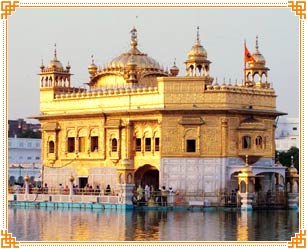 Arrive in Amritsar and check into the hotel. Arrive in Amritsar and check into the hotel.Relax or explore the markets and indulge in the delectable cuisine of Amritsar. Option to visit Ram Bagh Museum, palatial residence of Maharaja Ranjit Singh. Return to hotel for overnight stay. Day 02: In Amritsar Post breakfast, visit the Golden Temple for a "darshan", Gurdwara Baba Atal Sahib and the Jallianwala Bagh Memorial. The Jallianwala Bagh Memorial outside the temple honours those who lost their lives in the massacre on April 13, 1919. Other places worth visiting in the city are the Durgiana temple and the Ram Bagh Museum, ex-residence of Maharaja Ranjit Singh Return to hotel. Post lunch; option to rest or proceed to Wagah border to see the retreat ceremony, 35 km Return to hotel for overnight stay. Day 03: Amritsar - Dera Baba Nanak - Baba Bakala Post early breakfast, depart for Dera Baba Nanak near Gurdaspur, 55 km This was the home of Guru Nanak along the left bank of the river Ravi, before he departed for his heavenly abode A 'chola' worn by Guru Nanak during his visit to Mecca and Madina is preserved here After darshan and lunch, return to Amritsar via Baba Bakala. Here, Guru Tegh Bahadur meditated and was pronounced as the ninth Guru of the Sikhs. Overnight stay in Amritsar. Day 04: Amritsar - Tarn Taran Sahib - Goindwal Sahib Post breakfast, proceed for Gurudwara Tarn Taran Sahib, 22 km from Amritsar. It was dedicated to Guru Ram Das by Guru Arjan Dev in 1590. Located on the banks of the tank which is larger than the sarovar at Harmandir Sahib, it has a copper plated dome. After darshan and lunch depart for Gurudwara Sri Baoli Sahib. This was the first center for the Sikhs set up by Guru Amar Das, and part of the Goindval complex. It is an 8 metre wide open well which can be accessed through a covered flight of 84 stairs. Proceed to Gurudwara Sri Ber Sahib and Gurudwara Sri Hatt Sahib, both in Sultanpur Lodhi. The Gurudwara Ber Sahib is located at the site where Guru Nanak received a divine message from God, on one of the mornings he bathed at before meditation. He planted a jujube tree at the spot, and started his religious preaching from thereon. Gurudwara Sri Hatt Sahib is located on the premises where Guru Nanak worked as a young man for Nawab Daulat Khan Lodi. Overnight stay in Tarn Taran. Day 05: Tarn Taran - Bhatinda - Fatehgarh Sahib/Chandigarh Post early breakfast, depart for Bhatinda, 150 km. Visit Damdama Sahib where Guru Gobind Singh spent nine months working on the Adi Granth, and made it the centre of the Sikh religion Post lunch, depart for Sirhind, 205 km. Overnight stay in Sirhind. Day 06: Sirhind - Anandpur Sahib After early breakfast, visit Gurudwara Fatehgarh Sahib, Sirhind. It honours the tragic end of the two young sons of Guru Gobind Singhji for refusing the local official, Wazir Khan of Kunjpura to convert to Islam. After darshan, leave for Anandpur Sahib 130 km. Takht Sri Keshgarh Sahib, Anandpur Sahib, is the birthplace of the Khalsa. Guru Gobind 10th Guru of the Sikh religion baptized five of his disciples here and bestowed the title of "Singh" or lion, to them. Darshan at Anandpur Sahib. Overnight stay in Anandpur Sahib. Day 07: Anandpur Sahib - Amritsar/Chandigarh/onward destination Post breakfast, leave for either Amritsar/Chandigarh or onward destination Tour ends Amritsar has an international airport, with flights connecting it to London and Birmingham. The city has excellent road and rail links to all districts of Punjab and the rest of India. |
|
||||||